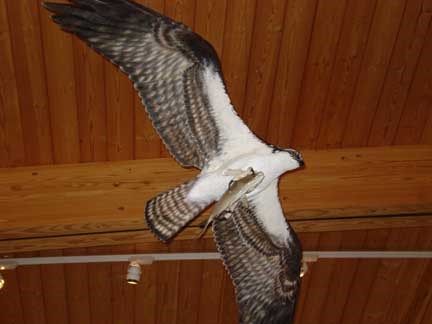
NPS Photo Who let the osprey into the building? A predator clutching its prey 'flew' overhead as some 70 people toasted and tasted hors d'oervres below. They had all gathered in mid-August to celebrate a milestone for the visitor experience at Jamaica Bay Wildlife Refuge. Jamaica Bay Wildlife Refuge is the only wildlife refuge in the National Park System. More than 325 bird species, nearly half of the species in the Northeast, have been sighted at the refuge over the last 25 years. It is one of the most important bird sanctuaries in the Northeastern United States and the best place in New York City to observe migratory birds. In addition, the refuge attracts thousands of human visitors each year from all across the globe. "The exhibits highlight that humans are and always have been an important part of Jamaica Bay," said Krause. Since the first inhabitants on its shores, people have shaped the nature of the bay and continue to be integral to its ecology. Today, the bay is perhaps the ‘wildest’ place in New York City, though it is not wilderness. In fact, in many respects it is a carefully managed natural area. Though seriously threatened by a number of environmental problems, Krause is hopeful for the future of the bay, “people love the bay, including me, and want to protect it and care for it. We are committed to keeping it a healthy vibrant ecosystem into the future.” Human history is just one piece of the puzzle of the bay and the natural history of the area is obviously a key piece as well. "As you enter the main exhibit space and look up you see an osprey in mid-flight with a fish in its talons heading to its perch. It really takes your breath away," Krause shared. The stunning exhibits were culmination of a vision that the staff, Harper’s Ferry Center, local organizations, the community and park enthusiasts shared. "We really listened to the community when they gave us feedback on these exhibits, it's what has made the final outcome such a success," she added. Artwork and photographs provided by volunteers, community members and NPS staff were utilized throughout the exhibit. The interpretive panels use a combination of bright, attractive colors, engaging text, three dimensional models and mechanical interactive exhibits to entice visitors to learn more about the diverse habitats. The goal is to encourage them to venture outside for a walk on the park's many trails and pathways. The exhibits also highlight the salt marsh, upland field and woods, several fresh and brackish water ponds. The importance of the open expanse of the bay itself and how the park is carefully managed for both wildlife and visitors is a key focus of the displays. Visitors can now embark on their Jamaica Bay Odyssey outside, with the information they need, to have not only a safe and enjoyable visit, but an educational and inspirational one as well. The LEED certified Visitor Contact Station prides itself in being green. Bamboo and cork floors, geothermal heating and cooling, solar photovoltaic panels on roof, energy conserving lighting and bathroom fixtures were all used in the building's construction. The area around the building is landscaped with native plants. The event was sponsored by the National Parks of New York Harbor Conservancy. |
Last updated: February 26, 2015
